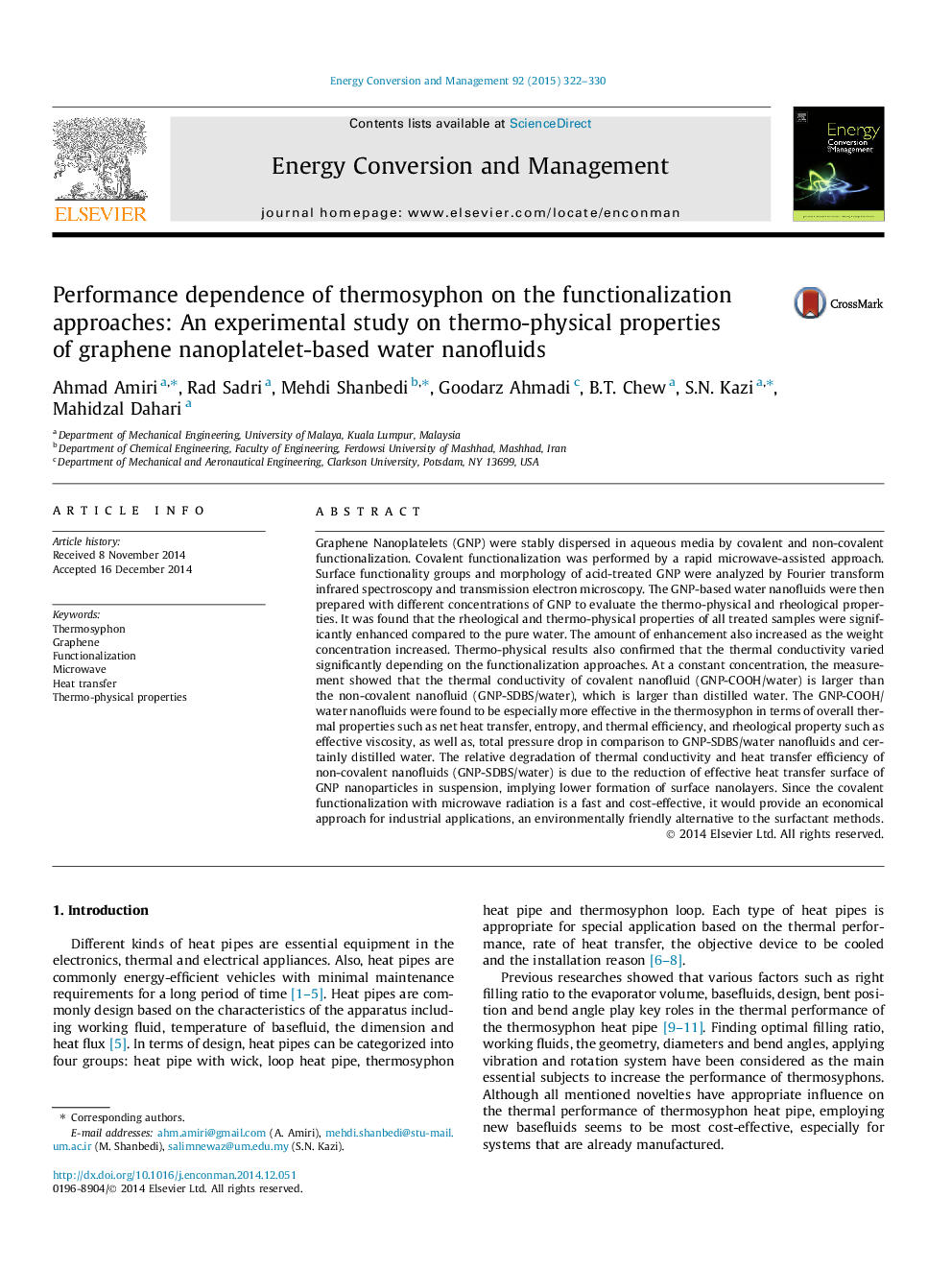| کد مقاله | کد نشریه | سال انتشار | مقاله انگلیسی | نسخه تمام متن |
|---|---|---|---|---|
| 7163220 | 1462870 | 2015 | 9 صفحه PDF | دانلود رایگان |
عنوان انگلیسی مقاله ISI
Performance dependence of thermosyphon on the functionalization approaches: An experimental study on thermo-physical properties of graphene nanoplatelet-based water nanofluids
ترجمه فارسی عنوان
وابستگی عملکرد ترموسفون به رویکردهای کاربردی: مطالعه تجربی بر روی خواص ترمو فیزیکی نانوسیم های آب مبتنی بر نانولوله های گرافن
دانلود مقاله + سفارش ترجمه
دانلود مقاله ISI انگلیسی
رایگان برای ایرانیان
کلمات کلیدی
ترموسفون، گرافن، کارکردن مایکروویو، انتقال گرما، خواص حرارتی فیزیکی،
موضوعات مرتبط
مهندسی و علوم پایه
مهندسی انرژی
انرژی (عمومی)
چکیده انگلیسی
Graphene Nanoplatelets (GNP) were stably dispersed in aqueous media by covalent and non-covalent functionalization. Covalent functionalization was performed by a rapid microwave-assisted approach. Surface functionality groups and morphology of acid-treated GNP were analyzed by Fourier transform infrared spectroscopy and transmission electron microscopy. The GNP-based water nanofluids were then prepared with different concentrations of GNP to evaluate the thermo-physical and rheological properties. It was found that the rheological and thermo-physical properties of all treated samples were significantly enhanced compared to the pure water. The amount of enhancement also increased as the weight concentration increased. Thermo-physical results also confirmed that the thermal conductivity varied significantly depending on the functionalization approaches. At a constant concentration, the measurement showed that the thermal conductivity of covalent nanofluid (GNP-COOH/water) is larger than the non-covalent nanofluid (GNP-SDBS/water), which is larger than distilled water. The GNP-COOH/water nanofluids were found to be especially more effective in the thermosyphon in terms of overall thermal properties such as net heat transfer, entropy, and thermal efficiency, and rheological property such as effective viscosity, as well as, total pressure drop in comparison to GNP-SDBS/water nanofluids and certainly distilled water. The relative degradation of thermal conductivity and heat transfer efficiency of non-covalent nanofluids (GNP-SDBS/water) is due to the reduction of effective heat transfer surface of GNP nanoparticles in suspension, implying lower formation of surface nanolayers. Since the covalent functionalization with microwave radiation is a fast and cost-effective, it would provide an economical approach for industrial applications, an environmentally friendly alternative to the surfactant methods.
ناشر
Database: Elsevier - ScienceDirect (ساینس دایرکت)
Journal: Energy Conversion and Management - Volume 92, 1 March 2015, Pages 322-330
Journal: Energy Conversion and Management - Volume 92, 1 March 2015, Pages 322-330
نویسندگان
Ahmad Amiri, Rad Sadri, Mehdi Shanbedi, Goodarz Ahmadi, B.T. Chew, S.N. Kazi, Mahidzal Dahari,
